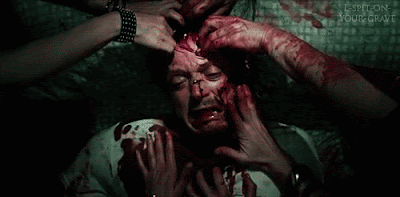* Through Yura's Gate
A girl named Yura constantly hears a voice that tells her to kill people and loathes it. She saves Ju, an angry boy from her school who always gets in fights, from drowning. Their story together involves random psychotic family members and murder. I wasn't really sure how it related to parasites, but it was an overall interesting story.
* Eat It Tonight Too
An old man's head is a parasite. As a young man, he married a woman he didn't love and had children with her. The man went through everything mechanically, only aging on purpose when people pointed it out. The ending is strangely emotional and sweet despite the dry tone of the story.
* Granny's Regrets
The art of this one is amazingly photorealistic with an old woman and the parasite whose toothy maw is on the side of her head. The parasite is bored and sees the opportunity to enter a bear with craziness ensuing. The story is short with a bit of humor.
* Paragant
This story is one of the few in full color. Parasites fight each other for money. The plot didn't really go anywhere, but the depictions of violence were impressive.
* Lucy and Migi
The art style was much more cutesy than the other stories and based in the world of Fairy Tale, which I also haven't read. A girl's hand is infected with a parasite from her cat. I didn't love or hate the story, but I lacked context.
* Teach Me Ryoko Tamya Sensei
There's a love triangle betweem a parasitic hand, a teacher, and a teenage boy. Not sure what I just read but it was weird.
* The Strange One
A parasite raised a family of his own and is confronted by another parasite. The first seems to truly love his family and covers it up by saying it's easier to transfer to the same bloodline. Another bizarrely sweet story.
* Perfect Soldier
The military have figured out that parasites are the best soldiers and hire them to fight against their own brethren. These particular parasites have heads that can morph into giant blades and this story had a bleak bent that made it one of the most memorable.
* Migi's Journey
Unattached parasite Migi encounters an old host in the city. The story is pretty dull. However, the background of each panel is insanely and intricately detailed.
* Edible
This is another of the blade-headed parasite stories. One is working for humans and his brother is working directly against him and his human team. The actions scenes are the highlight of the story.
* Kiser Ekoda Chan
This was my least favorite as it feature in parasite in a woman's vagina. The artwork is more cutesy like the Migi stories, but this one was weirdly vulgar and pointless.
* Chinless Gen and I are Parasites
This silly story has parasites being more metaphorical parasites, freeloading off of people and terrorizing them.
Overall, I liked some of the stories. I didn't realize it was based on anything, so I missed a lot of references and context that probably would have been useful.
My rating: 3/5 fishmuffins








































